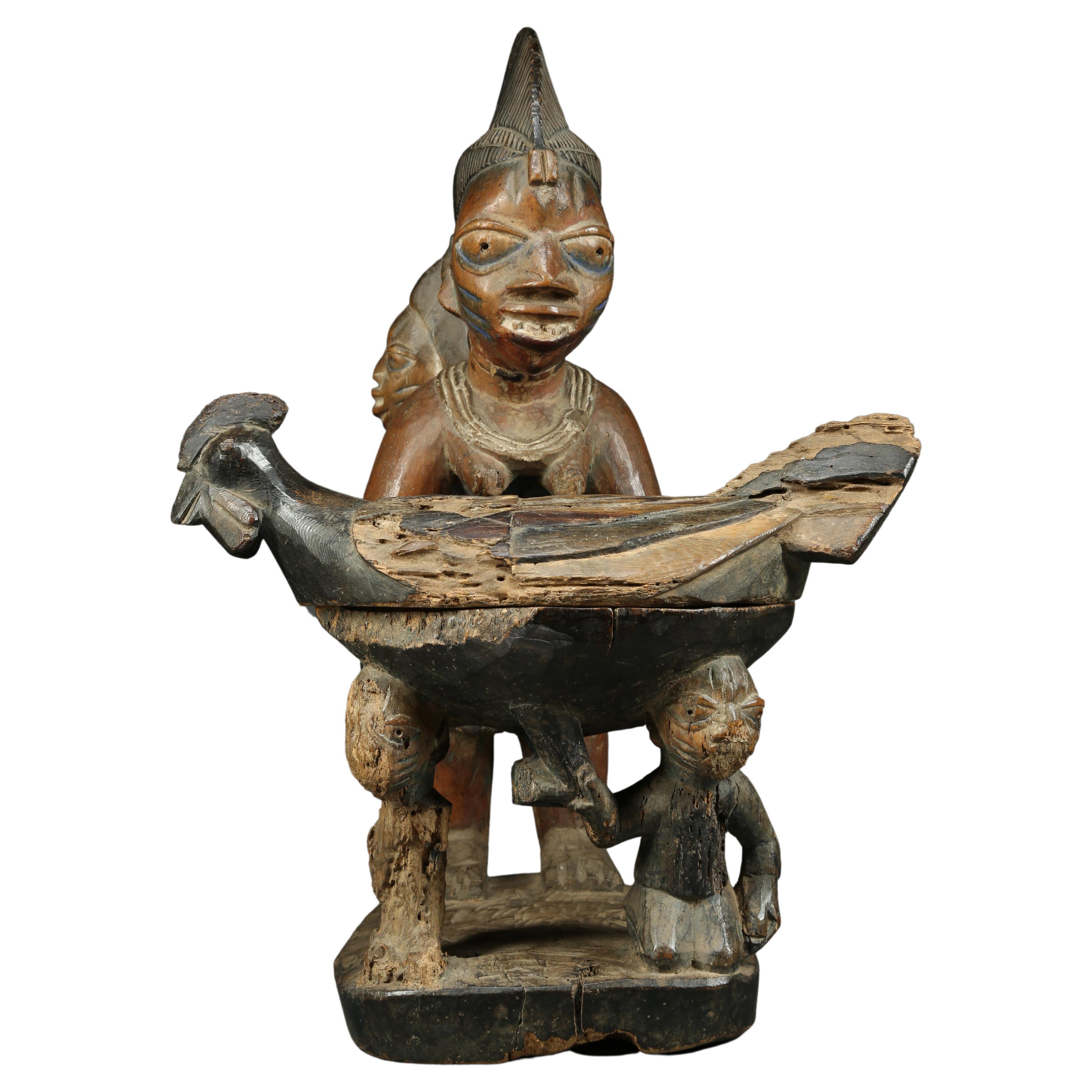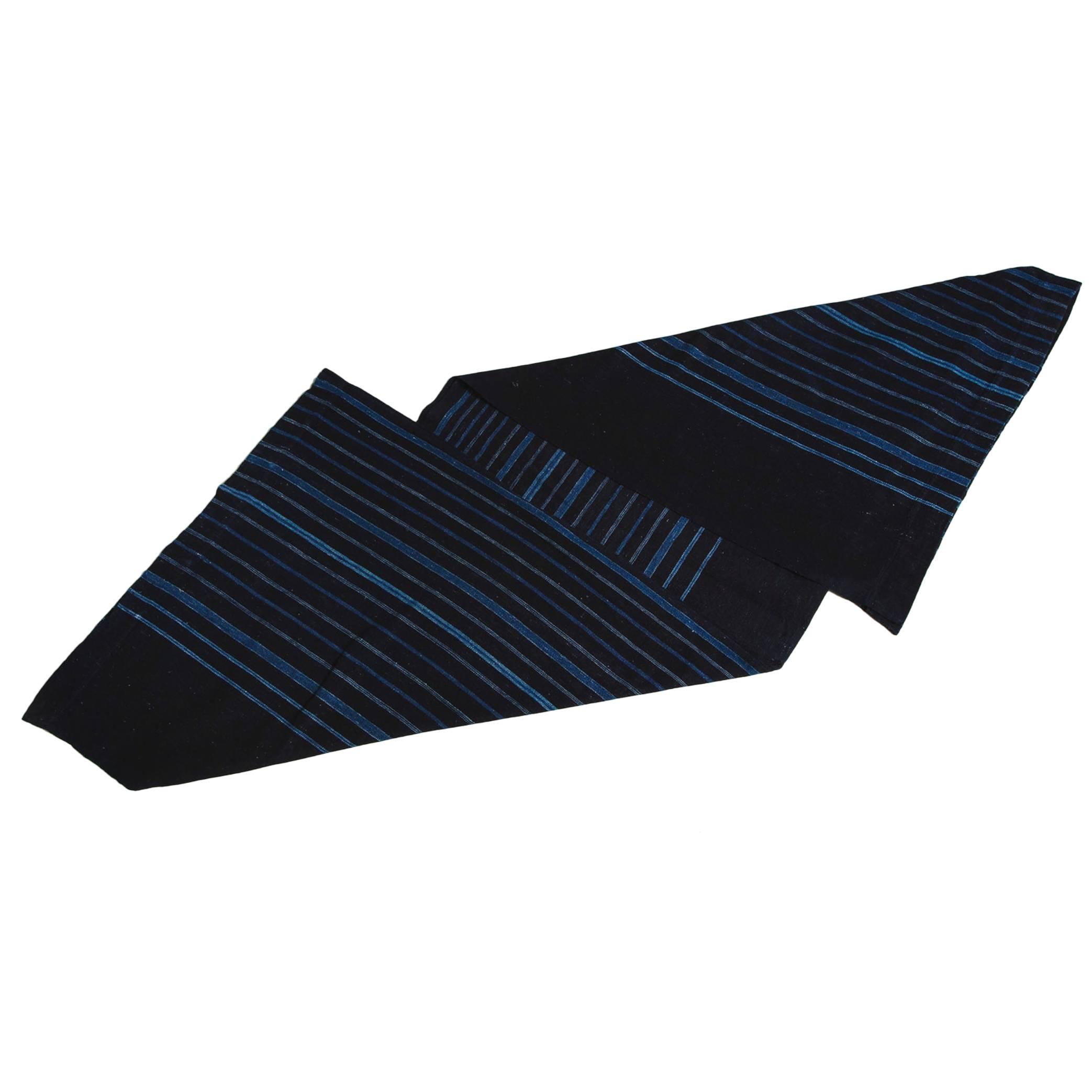Want more images or videos?
Request additional images or videos from the seller
1 of 10
Yoruba Maternity Group
About the Item
Yoruba Maternity Group
Wood, polychrome, pigment, scorching
Old collection name to base: ‘Sealy’ and ‘16.’
Nigeria
Late 19th Century
SIZE: 58cm high - 22¾ ins high
PROVENANCE:
Ex Ernest Ohly collection
Ex Berkeley Gallery, London
Purchased from G Block, 1960’s
Ex London Art Market
Ex Private collection
The Yoruba live predominantly in south western Nigeria and have for centuries been the most prolific art-producing people of Black Africa. The culture of Yoruba, with its complex religious, political and social systems inherited from ancient city-states, evoked the creation of a rich variety of royal and religious sculpture. The Yoruba developed a unique style through which to interpret the rituals and precepts, passions and beliefs of their lives. However, it is the actual community and family in the here and now that form the pivot of Yoruba life. There exists no desire to work toward a better life in the hereafter. While they do hope to join their ancestors when they die, these ancestors are conceived as living a formless existence that is nevertheless focused on the surviving family members in which they hope to be reborn. The ancestors do return to the community, but not through personal reincarnation. Their life force reverts to the community in the form of one or more children.
To the Yoruba the prime manifestation of the life force is fertility and women are the stronger sex as the life force manifests itself directly in them in the form of menstruation and childbirth. This shrine figure may have functioned as a water deity, being placed into a large dish during ceremonies in honour of the river goddess ‘Yemoja’ and carried around by a priestess in a trance. Yemoja is revered as a deity for bestowing the gift of children.
- Dimensions:Height: 22.75 in (57.79 cm)Width: 9 in (22.86 cm)Depth: 11 in (27.94 cm)
- Materials and Techniques:
- Place of Origin:
- Period:
- Date of Manufacture:Late 19th Century
- Condition:Wear consistent with age and use.
- Seller Location:London, GB
- Reference Number:1stDibs: LU9363237206762
About the Seller
No Reviews Yet
Vetted Seller
These experienced sellers undergo a comprehensive evaluation by our team of in-house experts.
Established in 1989
1stDibs seller since 2023
- ShippingRetrieving quote...Ships From: London, United Kingdom
- Return PolicyA return for this item may be initiated within 14 days of delivery.
More From This SellerView All
- An Exceptional Eastern Cape Nguni Pipe Bowl and StemLocated in London, GBAn Exceptional Eastern Cape Nguni Pipe Bowl and Stem Wood, metal Old inscription and dated: ‘1892’ South Africa 19th Century Size: 45.5cm long - 18 ins long Published: ‘The ...Category
Antique 19th Century South African Tribal Art
MaterialsWood
- A Rare and Exceptional Carved Headrest ‘Kali Hahapo’Located in London, GBA Rare and Exceptional Carved Headrest ‘Kali Hahapo’ Excellent colour and patina Wood, sennet (coconut fibre), glass beads Tonga Late 18th / Early 19th Century SIZE: 19cm high, 5...Category
Antique Early 19th Century Tongan Tribal Art
MaterialsNatural Fiber, Glass, Wood, Coconut
- A Rare and Historically Important Artefact Recovered from HMS Adventure in 1775Located in London, GBA Rare and Historically Important Artefact Recovered from HMS Adventure in 1775 after Captain James Cook’s Second Voyage to the Pacific A ‘coconut husker’ made by a ship’s carpenter aboard HMS Adventure in the style and design of a Native Islander’s ethnographical ‘coconut husker’ An engraved and inscribed copper plaque: A memento from The Sandwich Islands Coconut Husker used aboard HMS Adventure and recovered from The Royal Dockyard Deptford 1775 Oak, iron, brass, copper, handmade iron screws Fine rich colour and patina England / Sandwich Island 18th Century SIZE: 15.5cm high, 49.5cm long, 20cm wide (max) - 6¹⁄₈ ins high, 19½ ins long, 7⁷⁄₈ ins wide (max) Provenance: Found in a Scottish attic after centuries of lying hidden in a crate Ex Private Scottish collection Captain James Cook’s second voyage aboard the Resolution and accompanied by HMS Adventure set sail in July 1772. The discovery of the southern eight islands of the Sandwich Islands group was in 1775. The given name was chosen in honour of John Montagu, 4th Earl of Sandwich, First Lord of the Admiralty. The copper plaque and inscription however should not be read as The Sandwich Islands ‘Owhyhee’ (The Hawaiian Islands) which were later discovered on January 18th, 1778, on Captain Cook’s third voyage. Rather the inscription refers to ‘South Sandwich Islands’ lying to the south east of South Georgia and only renamed later with the word ‘South’ to distinguish them from the ‘Sandwich Islands’ now known as the Hawaiian Islands. Not withstanding during Cook’s second voyage he visited Easter Island, Tahiti, Society Islands, Niue, Tonga, New Hebrides, New Caledonia, Norfolk Islands, Palmerston Island and South Georgia. The crew onboard having been exposed to various types of ‘coconut huskers’ adapted those designs into the example we now see, having been rescued from HMS Adventure in 1775. A rare example of 18th century cross...Category
Antique 16th Century American Tribal Art
MaterialsBrass, Copper, Iron
- An Unusual Polynesian ‘Child’s’ Fighting ClubLocated in London, GBAn Unusual Polynesian ‘Child’s’ Fighting Club Old patina and mellow colour Wood Fiji 19th Century SIZE: 84.5cm long - 33¼ ins longù Provenance: Ex Welsh collection, sold at au...Category
Antique 19th Century Fijian Tribal Art
MaterialsWood
- An Exceptional New Zealand Māori Bugle-Flute ‘Pu Turino’Located in London, GBAn Exceptional New Zealand Māori Bugle-Flute ‘Pu Turino’ With soft and shallow surface decoration profusely carved with a dynamic scrolling motif made of two sections bound together with original and complete ‘Kiekie’ vine roots at four points The bow shaped mouth piece of anthropomorphic form with small rounded sounding hole to the end Soft silky smooth medium brown patina 18th Century Size: 33.5cm high, 4.5cm wide, 2.5cm deep - 13¼ ins high, 1¾ ins wide, 1 ins deep Provenance: Collected by Robert Nutter Campbell 4th Regiment of Madras Native Infantry on his return from Singapore 1829 Thence by descent Sold Sothebys, New York, May 17, 2002, lot 368 Ex Private English collection Ex Finch and Co...Category
Antique 18th Century New Zealand Tribal Art
MaterialsWood
- An Unusual ‘Kanak’ Hardwood War ClubLocated in London, GBAn Unusual ‘Kanak’ Hardwood War Club Fine dark glossy patina from use, a lighter band where a now lost ‘binding’ would have acted also as a ‘wrist thong’ Wood New Caledonian, Kanak E...Category
Antique Early 19th Century New Caledonian Tribal Art
MaterialsWood
You May Also Like
- Yoruba Tribal Maternity Offering Bowl Figure Chicken, Nigeria Africa weatheredLocated in Point Richmond, CABlessed by time, an early beautiful Yoruba female figure with baby riding on back, presenting an offering bowl in the form of a chicken with a removable top. Great Yoruba mother's face with scarifications and an excited baby. Areas of heavy wear, erosion and insect damage, especially to the two figures supporting the bowl, top of the chicken bowl...Category
Early 20th Century Nigerian Tribal Tribal Art
MaterialsWood
- Beaded Yoruba StaffLocated in Chicago, ILThe Yoruba people reserve the use of glass beads for royalty, priests and priestesses, as well as embellishing ritual and ceremonial objects. Though only kings are allowed to use bea...Category
Mid-20th Century South African Folk Art Tribal Art
MaterialsMetal, Iron
- Yoruba Indigo ClothLocated in Greenwich, CTHand dyed Yoruba (Nigeria) cloth from the Esie area, 1950s.Category
Vintage 1950s Nigerian Tribal Art
MaterialsCotton
- Yoruba Ibeji pairLocated in London, GBIbeji pair Ajasse Nigeria Wood, beads, pigment, offering remains 26.5cm and 25cm ex Beatrice Leutert and Marcel Plüss collection, Thurgau, SwitzerlandCategory
Early 20th Century Tribal Art
MaterialsWood
- Wooden Baoule Maternity Figure, AfricaLocated in San Pedro Garza Garcia, Nuevo LeonInteresting maternity figure in a hieratic pose presenting a young adolescent. Beautiful facial expression, showing wisdom and knowledge. She is sitti...Category
20th Century Ivorian Tribal Figurative Sculptures
MaterialsWood
- Yoruba Beaded Sash, c. 1950Located in Chicago, ILThis intricately-constructed colorful train was painstakingly created by Yoruba artisans in Nigeria in the mid-20th century. Recent designs such as this were based upon...Category
Mid-20th Century Nigerian Tribal Art
MaterialsShell, Fabric, Beads
Recently Viewed
View AllMore Ways To Browse
Tribal Fertility
Fertility Form
Sex Furniture
Antique Furniture South Africa
South African Antique Furniture
River Of No Return
Antique Furniture In South Africa
African Antiques
African Life Size
Berkeley Used Furniture
Revert Furniture
African Wood Block
Goddess Dior
Antique African Wood Sculptures
Religious Shrine
Folk Art 1960s Wood Sculpture
Ancestor Figure
Antique Childrens Blocks





